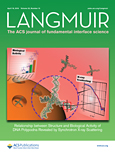A pair of chemical engineers has retracted a paper after another researcher was unable to replicate their work, in a case that we consider an example of doing the right thing.
Dennis Prieve, at Carnegie Mellon University, was interested in applying the paper — on how systems of molecules known as “reverse micelles” conduct electrical charge — to his own work, but was having trouble repeating the calculations. So Prieve contacted the authors — John Berg and his PhD student Edward Michor, based at the University of Washington — who supplied him with their original data.
It took several weeks of back and forth to figure out the problem, Michor told us, as the paper was published in 2012, so he had to decipher his old notes. When they found that several incorrect values were used in the paper, the authors issued a retraction notice, published in March:
It has been brought to the authors’ attention by Prof. Dennis C. Prieve that an error was present in the article titled, “Extension to the Charge Fluctuation Model for the Prediction of the Conductivity of Apolar, Reverse Micellar Systems,” by Edward L. Michor and John C. Berg, which necessitates the retraction of said article. This article was published on pages 15751− 15755 of volume 28, issue 45, of Langmuir.
The purpose of the article was to propose an extension to the current theory regarding the charging behavior of reverse micellar systems in apolar media.
The paper has been cited four times, according to Thomson Reuters Web of Science.
The error — explained in great detail in the page-long notice — is that:
The values of CT, the total concentration of reverse micelles, used in the article, however, were incorrect, being approximately 2 orders of magnitude too large.
The notice provides a new figure based on the correct values, and explains why the mistake weakens the theory presented in the paper:
The conductivities predicted by the extended theory (eq 3) are now 30−100× lower than experimental values, while conductivities predicted by the original theory (eq 2) are closer to experimental values, but still lower by a factor of 5−12. It is clear that the extended theory does not provide a better representation of the experimental systems. Thus, the issue of how reverse micelles are actually charging in apolar systems remains open. It may be the case that the use of the Born equation for the calculation of self-energies of such small systems is invalid, resulting in much higher energies than are realistic. These higher energies would suggest that reverse micellar charging is less favorable than in reality and predict lower conductivities.
Prieve told us how he found the mistake:
My research group is performing similar experiments measuring conductivities of surfactant-doped nonpolar media. The agreement between theory and experiment reported in their 2012 Langmuir article was much better than earlier theories so I tried to repeat the calculations myself with the intention of extending their theory to our experiments. The 2012 paper contained all the details needed.
When I kept getting a different prediction from theirs, I contacted Prof. Berg, who I have known for more than 30 years. He put me in touch with his former PhD student and co-author Ed Michor who kindly sent me his Excel spreadsheet containing the data and their calculations.
After I pointed out the error, Prof. Berg sent me a draft of the retraction. I then encouraged him not to retract the article which also contains useful new data. I felt that an erratum was more appropriate. Of course correcting the mistake completely negates the conclusion of the 2012 paper so I guess Berg decided that retraction was the right course.
Michor explained:
We had tried for for several more weeks to determine what could be done to our model to improve it, but everything we had tried made it worse. Because of this, we decided to retract the paper, since there was no easy “correction” to make our model better than the old one.
He added:
If I learned anything from this, it was to check, check, and re-check everything that I do. So much of my research involves rather vast spreadsheets with hundreds and thousands of calculations and values. It’s all too easy to make a mistake early on in a calculation and have it carry through everything. It was somewhat funny that this mistake actually made things better (rather than worse), but mistakes don’t belong in the scientific literature.
Like Retraction Watch? Consider making a tax-deductible contribution to support our growth. You can also follow us on Twitter, like us on Facebook, add us to your RSS reader, sign up on our homepage for an email every time there’s a new post, or subscribe to our new daily digest. Click here to review our Comments Policy. For a sneak peek at what we’re working on, click here.

Real scientists engaged in research – so refreshing compared to what is usually catalogued here. Hats off to all involved and a nicely detailed retraction notice or RW to pin to the wall
as a reminder of how the world should be!